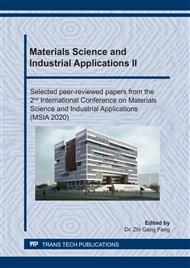[1]
J.F. Watts, X-ray photoelectron spectroscopy, Vacuum, 45 (1994) 653-671.
Google Scholar
[2]
C.S. Fadleys, X-ray photoelectron spectroscopy: From origins to future directions, Nucl. Instrum. Methods Phys. Res. Sect. A-Accel. Spectrom. Dect. Assoc. Equip., 601 (2009) 8-31.
Google Scholar
[3]
C. Weiland, A.K. Rumaiz, P. Pianetta, J.C. Woicik, Recent applications of hard x-ray photoelectron spectroscopy, Journal of Vacuum Science & Technology A, 34 (2016) 21.
DOI: 10.1116/1.4946046
Google Scholar
[4]
S. Stankovich, D.A. Dikin, R.D. Piner, K.A. Kohlhaas, A. Kleinhammes, Y. Jia, Y. Wu, S.T. Nguyen, R.S. Ruoff, Synthesis of graphene-based nanosheets via chemical reduction of exfoliated graphite oxide, Carbon, 45 (2007) 1558-1565.
DOI: 10.1016/j.carbon.2007.02.034
Google Scholar
[5]
S. Watcharotone, D.A. Dikin, S. Stankovich, R. Piner, I. Jung, G.H.B. Dommett, G. Evmenenko, S.-E. Wu, S.-F. Chen, C.-P. Liu, S.T. Nguyen, R.S. Ruoff, Graphene−Silica Composite Thin Films as Transparent Conductors, Nano Letters, 7 (2007) 1888-1892.
DOI: 10.1021/nl070477+
Google Scholar
[6]
Z. Liu, Q. Liao, D. Yang, Y. Gao, X. Luo, Z. Lei, H. Li, Well-defined poly(N-isopropylacrylamide) with a bifunctional end-group: synthesis, characterization, and thermoresponsive properties, Designed Monomers and Polymers, 16 (2012) 465-474.
DOI: 10.1080/15685551.2012.747165
Google Scholar
[7]
l. Kou, Z. Liu, T. Huang, B. Zheng, C. Gao, z. tian, z. deng, Wet-spun, Porous, Orientational Graphene Hydrogel Films for High-performance Supercapacitor Electrodes, Nanoscale, 7 (2015) 4080-4087.
DOI: 10.1039/c4nr07038k
Google Scholar
[8]
A. Kovtun, D. Jones, S. Dell'Elce, E. Treossi, A. Liscio, V. Palermo, Accurate chemical analysis of oxygenated graphene-based materials using X-ray photoelectron spectroscopy, Carbon, 143 (2019) 268-275.
DOI: 10.1016/j.carbon.2018.11.012
Google Scholar
[9]
V.B. Mohan, L. Jakisch, K. Jayaraman, D. Bhattacharyya, Role of chemical functional groups on thermal and electrical properties of various graphene oxide derivatives: a comparative x-ray photoelectron spectroscopy analysis, Mater. Res. Express, 5 (2018).
DOI: 10.1088/2053-1591/aab316
Google Scholar
[10]
Z. Li, Z. Liu, H. Sun, C. Gao, Superstructured Assembly of Nanocarbons: Fullerenes, Nanotubes, and Graphene, Chem. Rev., 115 (2015) 7046-7117.
DOI: 10.1021/acs.chemrev.5b00102
Google Scholar
[11]
S. Rella, A. Giuri, C.E. Corcione, M.R. Acocella, S. Colella, G. Guerra, A. Listorti, A. Rizzo, C. Malitesta, X-ray photoelectron spectroscopy of reduced graphene oxide prepared by a novel green method, Vacuum, 119 (2015) 159-162.
DOI: 10.1016/j.vacuum.2015.05.008
Google Scholar


